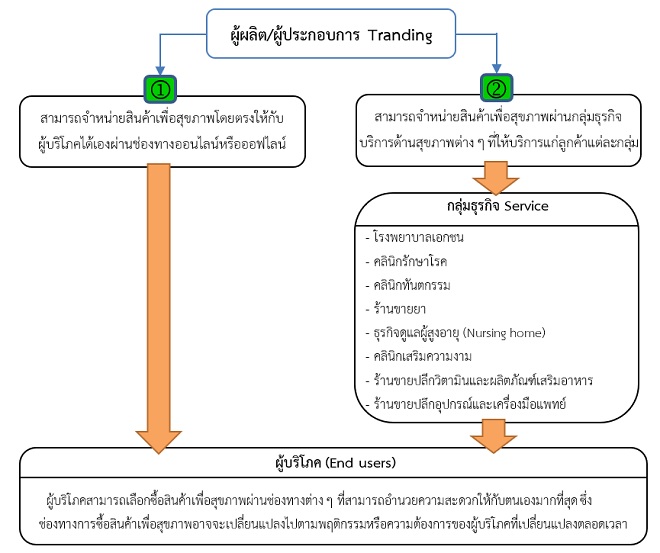INTEGRATED MARKETING COMMUNICATION STRATEGIES OF DIETARY SUPPLEMENT IN NORTHEAST PART OF THAILAND
DOI:
https://doi.org/10.14456/nrru-rdi.2022.14Keywords:
Integrted marketing communication, Purchase decision, Dietary supplement, EntrepreneurAbstract
This study integrated the marketing communication strategies of dietary supplement in Northeastern Region of Thailand. Its purposes were to study the level of opinions, the influence of consumer purchasing decisions, and develop strategies. The quantitative research was the purposive sample in the elderly, ages of 60-79 years, a stratified random sampling total 400 participants, use a 5-level estimation scale questionnaire with the reliability of 0.987 value in collect the online information. The results were analyzed by frequency, percentage, mean and standard deviation and test hypothesis by multiple regression analysis. For the target group in the qualitative research, a specific selection was divided into a group of 38 experts, using an interview from an advisor' approval, the suitability assessment was collected by in-depth interviews of 30 participants to formulate a strategy, and collecting information by organizing a forum to critique with eight experts and analyze the summary as the developed strategies. The results of the study showed that 1) the sample group gave their opinions about the importance of integrated marketing communications and purchasing decisions at a high level; 2) the integrated marketing communication had a positive influence on the purchasing decisions of internet consumers at the highest level, which can be developed into strategies such as advertising, product display, sales channel, adjustment social events, product identity creation and spatial sales activities.
References
Belch, G. E., & Belch, M. A. (2004). Advertising & Promotion (6th ed.). New York, NY : McGraw-Hill/Irwin.
Best, J. W. (1997). Research in Education (3rd ed.). Englewood Cliffs N. J. : Prentice-Hall.
Chaiwat, K. (2015). Advertising and Promotion. Bangkok : SE-Education. (In Thai)
Chansukri, P., & Kaewchankha, W. (2018). Campus Food Environments Influencing Healthy Eating Behaviors among Thai University Students. Research report. Research Office, National Institute of Development Administration. (In Thai)
Chuengsomchetphaisan, P. (2017). Advisor to Office of the Permanent Secretary, Ministry of Public Health. Interview. (In Thai)
Cronbach, L J. (1984). Essential of Psychology and Education. New York : Mc-Graw Hill.
Etzel, M. J., Walker, B. J., & Stanton, W. J. (2001). Marketing management. Boston, MA : McGraw-Hill.
Gibson, A. (2002). The emerging role of integrated marketing in the pharmaceutical industry. Journal of Integrated Communications, 2003, 23-28.
Hair, J. F., Black, W. C., Babin, B. J., & Anderson, R. E. (2010). Multivariate data analysis (7th ed.). Upper Saddle River, NJ : Prentice Hall.
Iamsuphachok, P. (2018). Integrated marketing communication and marketing mix that affects to the behavior and buying decision of channel 3 employees about car air freshener. Thesis, Master of Arts Program in Strategic Communication, Graduate School, Bangkok University, Bangkok. (In Thai)
K SME Analysis. (2017). Ko-Krasae-Sinkha-Sukkhaphap-Sang-Okat-Thurakit. Bangkok : Kaskornbank. (In Thai)
Kitchen, P. J., Schultz, D. E., Kim, I., Han, D., & Tao Li. (2004). Will agencies ever ”get” (or understand) IMC?. European Journal of Marketing, 38(11/12), 1417-1436
Kotler, P. (2003). Marketing Management (11th ed.). Singapore : Prentice-Hall.
Krejcie, R. V., & Morgan, D. W. (1970). Determining Sample Size for Research Activities. Educational and Psychological Measurement, 30(3), 607-610.
Naeem, B., Bilal, M., & Naz, U. (2013). Integrated marketing communication: a review paper. Interdisciplinary journal of contemporary research in business, 5(5), 124-133.
National Statistical Office. (2019). Chammuan-Prachakon-Chak-Tha-Yen-Chamnaek-Tam-Klum-Ayu-Rai-Changwat-Lae-Phak-Phoso-2554-2563. Retrieved December 16, 2019, from tatbbi. nso.go.th/staticreport/page/sector/th/01.aspx (In Thai)
Panyarot, S. (2014). Marketing out of formula strategy. Bangkok : Phetpraguy. (In Thai)
Pattanakulkamjorn, R., & Sawang, S. (2021). Integrated Marketing Communications and the Reference Group Influencing Consumer Decision of Non-Franchise Coffee Café in Nonthaburi Province. MUT Journal of Business Administration, 18(1), 95-115. (In Thai)
Rovinelli, R. J., & Hambleton, R. K. (1977). On the use of content speciatlists in the assessment of criterion-referenced test item validity. Dutch Journal of Educational Research, 2, 49-60.
Russell, J. T., & Lane, W. R. (2002). Kleppner’s advertising procedure (15th ed.). Upper Saddle River, New Jersey : Prentice Hall.
Shimp, R. J. (2000). Advertising, Promotion, and other Supplemental Aspects of Integrated Marketing Communications (5th ed.). Hinsdale : Dryden Press.
Srisathitnarakun, B. (2010). Research methodology in nursing science (5th ed.). Bangkok : U & I Intermedia. (In Thai)
The Federation of Thai Industries. (2018). Thai Industries Sentiment Index 2561. Retrieved May 20, 2019, from https://sites.google.com/a/ftikm.com/demokm/khaw-den/dachnikhwamcheuxmanphakh xutsahkrrmdeuxnsinghakhm2561?overridemobile=true (In Thai)
TMB Analysis. (2018). Naeonom-Thurakit-Ahan-Some-Nai-Yuk-Online-Khrongmueang. Retrieved May 20, 2018, from https://media.tmbbank.com/uploads/analytics_industry/file/media/523_file_ th.pdf?180514014202 (In Thai)
Wanichbuncha, K. (2011). Statistical analysis : Statistics for administration and research (13th ed.). Bangkok : Chulalongkorn University Press. (In Thai)
Witoowinit, W., & Intuluck, W. (2019). The Effect of Integrated Marketing Communication on the Buying Decision of Halal Products View of Different Generation Customers in Bangkok. Dusit Thani College Journal, 14(1), 349-363. (In Thai)

Downloads
Published
How to Cite
Issue
Section
License

This work is licensed under a Creative Commons Attribution-NonCommercial-NoDerivatives 4.0 International License.




